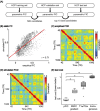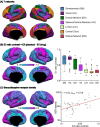This is a preprint.
In-vivo whole-cortex marker of excitation-inhibition ratio indexes cortical maturation and cognitive ability in youth
- PMID: 38586012
- PMCID: PMC10996460
- DOI: 10.1101/2023.06.22.546023
In-vivo whole-cortex marker of excitation-inhibition ratio indexes cortical maturation and cognitive ability in youth
Update in
-
In vivo whole-cortex marker of excitation-inhibition ratio indexes cortical maturation and cognitive ability in youth.Proc Natl Acad Sci U S A. 2024 Jun 4;121(23):e2318641121. doi: 10.1073/pnas.2318641121. Epub 2024 May 30. Proc Natl Acad Sci U S A. 2024. PMID: 38814872 Free PMC article.
Abstract
A balanced excitation-inhibition ratio (E/I ratio) is critical for healthy brain function. Normative development of cortex-wide E/I ratio remains unknown. Here we non-invasively estimate a putative marker of whole-cortex E/I ratio by fitting a large-scale biophysically-plausible circuit model to resting-state functional MRI (fMRI) data. We first confirm that our model generates realistic brain dynamics in the Human Connectome Project. Next, we show that the estimated E/I ratio marker is sensitive to the GABA-agonist benzodiazepine alprazolam during fMRI. Alprazolam-induced E/I changes are spatially consistent with positron emission tomography measurement of benzodiazepine receptor density. We then investigate the relationship between the E/I ratio marker and neurodevelopment. We find that the E/I ratio marker declines heterogeneously across the cerebral cortex during youth, with the greatest reduction occurring in sensorimotor systems relative to association systems. Importantly, among children with the same chronological age, a lower E/I ratio marker (especially in association cortex) is linked to better cognitive performance. This result is replicated across North American (8.2 to 23.0 years old) and Asian (7.2 to 7.9 years old) cohorts, suggesting that a more mature E/I ratio indexes improved cognition during normative development. Overall, our findings open the door to studying how disrupted E/I trajectories may lead to cognitive dysfunction in psychopathology that emerges during youth.
Figures






References
-
- Turrigiano G. G. & Nelson S. B. Homeostatic plasticity in the developing nervous system. Nat Rev Neurosci 5, 97–107 (2004). - PubMed
Publication types
Grants and funding
- RF1 MH121867/MH/NIMH NIH HHS/United States
- R37 MH125829/MH/NIMH NIH HHS/United States
- R01 MH120482/MH/NIMH NIH HHS/United States
- RF1 MH116920/MH/NIMH NIH HHS/United States
- R01 MH113550/MH/NIMH NIH HHS/United States
- T32 MH014654/MH/NIMH NIH HHS/United States
- U54 MH091657/MH/NIMH NIH HHS/United States
- R01 MH133334/MH/NIMH NIH HHS/United States
- K99 MH127293/MH/NIMH NIH HHS/United States
- RC2 MH089983/MH/NIMH NIH HHS/United States
- T32 MH019112/MH/NIMH NIH HHS/United States
- R01 EB022573/EB/NIBIB NIH HHS/United States
- R01 MH112847/MH/NIMH NIH HHS/United States
- RC2 MH089924/MH/NIMH NIH HHS/United States
- R01 MH120080/MH/NIMH NIH HHS/United States
LinkOut - more resources
Full Text Sources
